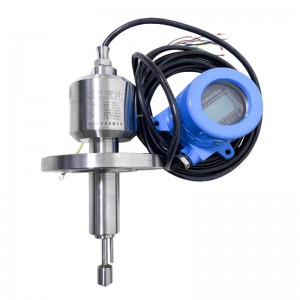Choose Lonnmeter for accurate and intelligent measurement!
Inline Paint Viscometer
It's also known as an inline ink viscosity meter or inline viscosity meter for ink for its outstanding performance in ink production lines. It's commonly installed in the supply line pipeline that carries ink from the main reservoir/tank/pump to the doctor blade chamber or the ink pan, providing immediate feedback on the ink viscosity just before it reaches the anilox roller or gravure cylinder. Looking into its working principle and see how it works in automated process control.
Working Principle
The inline paint viscosity meter consists of a sensor probe and a transmitter, designed for installation in reactors, reaction tanks, or pipelines to measure liquid viscosity in real time. It employs a solid rod-shaped sensing element that vibrates sinusoidally at a specific frequency, oscillating torsionally along its axis. The sensor features a single exposed element, enabling free fluid flow across its surface. As the element shears through the fluid, it experiences energy loss due to viscous drag forces, which vary with the fluid's viscosity resistance. This energy dissipation is detected by electronic circuitry and processed by the transmitter to generate a readable viscosity value.
Optional Material of Wetted Parts
316 L, Teflon, Hastelloy
Repeatability
±1% ~ 2%
Wide Viscosity Range
1 - 1,000,000 cP
Product Features
• Real-time continuous measurement enable immediate process adjustment to maintain consistent film thickness and color;
• Wide viscosity range handles low to high viscosities up to 1,000,000 cP;
• Built-in high-accuracy RTD sensor allows for automatic temperature compensation;
• High accuracy ±2% ~ 5% and repeatability ±1% ~ 2%;
• No-moving-parts design minimizes clogging, abrasion and maintenance;
• Robust and chemical resistant material stands up to corrosive solvents, pigments and cleaning chemicals;
• Threaded and flanged connections enable easy integration into pipeline, mixing tank or applicator feed line;
Benefits of Paint Viscometer
• Eliminates coating defects like runs and sags, orange peel or mottling, poor adhesion, etc.;
• Maintain tight viscosity control to ensure target film thickness;
• Real-time process control replaces time-consuming lab or efflux cup sampling;
• Increase throughput by keeping correct viscosity and lowering possibilities of re-work, scraping and repainting;
• Low-maintenance sensor reduce production downtime;
• Prevent over-thinning and over-addition of raw materials;
• Continuous monitoring make predictive maintenance possible;
OEM & ODM Service
• Viscosity range customization;
• Material Customization of wetted parts;
• Probe length customization
Contact our engineers right now if you need exclusive OEM and ODM service.












